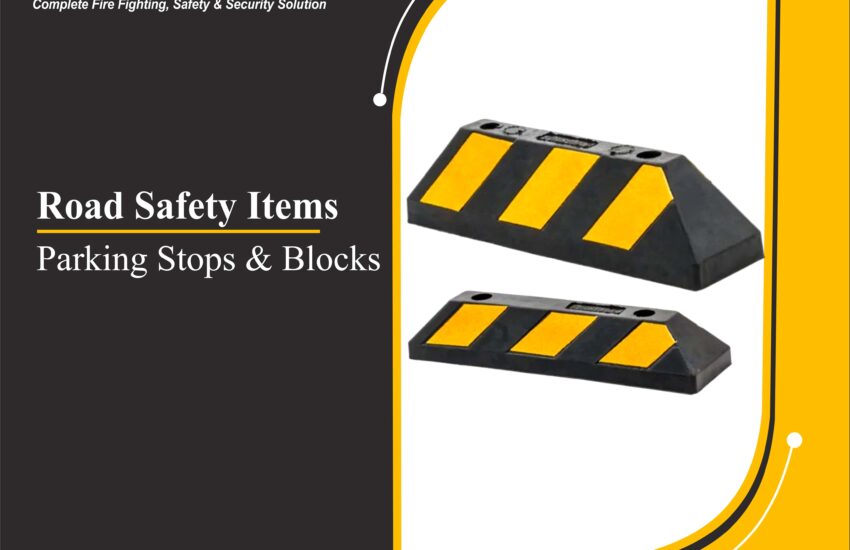Parking Stops & Blocks are essential for guiding vehicles safely and accurately into designated parking spaces. These simple but effective tools help prevent damage to vehicles, buildings, landscaping, and pedestrians by offering a physical boundary that signals drivers when to stop. From busy commercial lots to quiet home garages, parking stops are a smart and low-cost way to enhance safety and organization.
With options made from concrete, recycled plastic, and rubber, parking stops serve a wide range of applications — including for cars, trucks, motorcycles, and buses — across parking garages, driveways, commercial lots, and special-purpose areas.
Types of Parking Stops
Concrete Parking Stops
Concrete parking stops are among the most common types used in traditional parking lots. Their heavy weight makes them stable and long-lasting, often providing decades of use with proper maintenance.
Benefits:
- Very durable and stable
- Long lifespan (up to 50 years)
- Affordable material cost
Drawbacks:
- Expensive to ship due to weight
- Difficult to install manually
- Painted surfaces require frequent touch-ups
- Can break down over time and become safety hazards
Best Use On:
Perfectly flat, hard concrete surfaces where long-term installation is needed.
Recycled Plastic Parking Stops
Plastic parking blocks are lightweight, modern, and extremely durable. Made from 100% recycled materials, these stops resist cracks, fading, and chemical damage.
Benefits:
- Lightweight and easy to install
- Comes in a variety of colors and sizes
- Resistant to oil, gas, UV rays, and salt
- Color molded in – no repainting needed
- Won’t damage vehicles on impact
Drawbacks:
- Most expensive option
- Not suitable for gravel or uneven asphalt
Best Use On:
Smooth concrete or asphalt surfaces where long-term aesthetics and performance are a priority.
Recycled Rubber Parking Stops
Rubber stops are the perfect balance between cost and performance. They are flexible, weather-resistant, and designed to absorb minor impacts without cracking or chipping.
Benefits:
- Extremely durable and flexible
- Resistant to UV rays, moisture, oil, and gas
- Can be driven over without vehicle damage
- Reflective tape options available for night visibility
- Easy to install on most surfaces
Drawbacks:
- More expensive than concrete
- Slightly less rigid compared to plastic
Best Use On:
Any paved or gravel surface, especially where visibility and flexibility are needed.
Available Colors for All Types
- Solid Yellow – Highly visible in snow or low-light
- Solid Gray – Subtle look, blends with concrete
- Solid White – Matches line markings; less visible in snow
- Accessibility Blue – ADA-compliant spaces
- Black with Reflective Yellow or White Stripes – Great for nighttime visibility
- Accessibility Blue with Reflective White Stripes – ADA-approved and highly visible
Standard Sizes
- 2-Foot Stops: For larger vehicles like trucks and buses
- 3- & 4-Foot Stops: Ideal for home garages and small parking areas
- 6-Foot Stops: Standard size for commercial parking lots
- 8-Foot Stops: Perfect for wide-axle commercial trucks
- Custom Lengths: Place units end-to-end for bike lanes, pedestrian protection, or unique layouts
Installation Hardware Options
Installation varies by surface type. Be sure to choose the correct hardware:
- Asphalt Surfaces: Galvanized steel spikes or lag bolts
- Concrete Surfaces: Lag bolts or Tapcon concrete anchors
Most parking stops come with hardware, but confirm before purchasing to ensure you have what you need for secure, long-term installation.
Enhancing Safety in Parking Areas
Whether used in parking garages, commercial lots, schools, warehouses, or residential driveways, parking blocks are critical tools for:
- Guiding vehicles into correct positions
- Preventing over-rolling and property damage
- Enhancing safety for pedestrians
- Clearly designating handicap-accessible or special-use spaces
- Organizing parking spaces efficiently
When the right material, color, size, and mounting hardware are selected, parking stops become an essential part of a well-maintained, safe, and visually organized parking environment.


